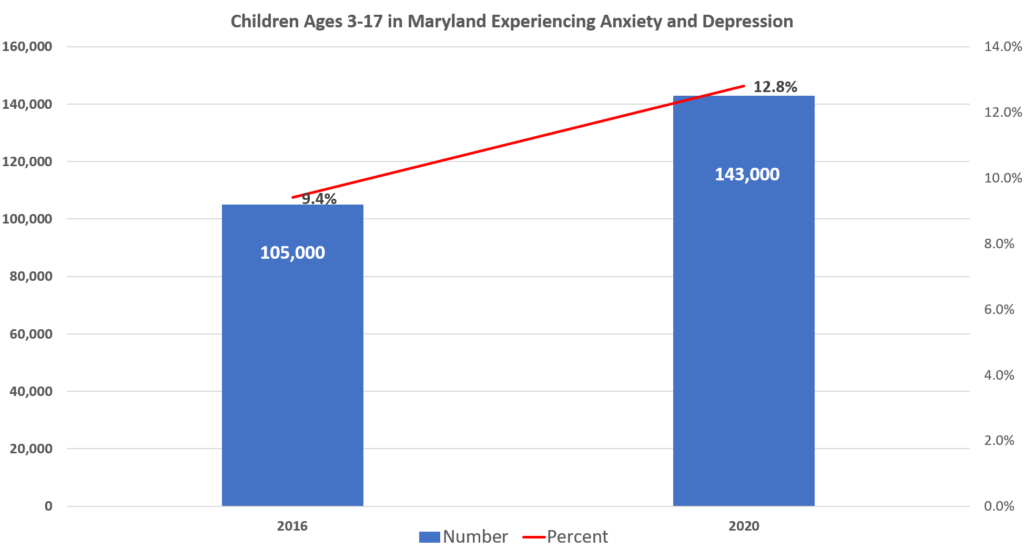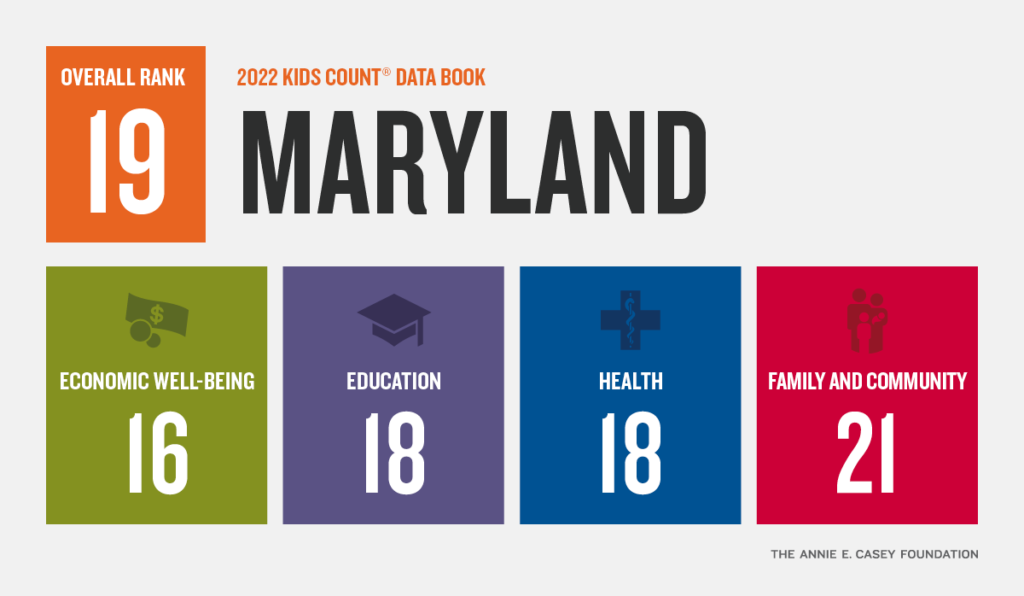KIDS COUNT: Maryland’s Children Are Experiencing Higher Rates of Anxiety and Depression
Content note: This post references data points related to suicide.
Maryland ranks 19th in child well-being according to the 2022 KIDS COUNT® Data Book, just released by The Annie E. Casey Foundation. The Kids Count data book, released annually (this is the 33rd edition), is a 50-state report of recent household data developed by the Annie E. Casey Foundation that analyzes how children and families are faring. Each year, the Data Book presents national and state data from 16 indicators in four domains —economic well-being, education, health, and family and community factors — and ranks the states according to how children are faring overall.
The data in this year’s report are a mix of pre-pandemic and more recent figures. Massachusetts, New Hampshire and Minnesota rank first, second and third in overall well-being in the 2022 Data Book; Mississippi, Louisiana and New Mexico ranked 48th, 49th and 50th. The report this year focuses on youth mental health and highlights how health, economic conditions and other factors are affecting children in the United States particularly children of color.
Mental Health
The Data Book shows that the pandemic years have taken a toll on everyone and exacerbated a rising crisis in mental health for children and youth. Children across Maryland were more likely to encounter anxiety and depression during the first year of the COVID-19 pandemic than previously, with state figures soaring by 36%, from 9.4% of children ages 3-17 (105,000 young people) to 12.8% (143,000 young people) between 2016 and 2020. This increase represents 38,000 more children who are struggling to make it through the day. Maryland children experienced anxiety and depression at slightly higher rates than the national average in 2020, the report found.
 The report shows that racial and ethnic disparities contribute to disproportionately troubling trends in mental health and wellness among children of color. Nationally nearly 10% of high schoolers overall but 12% of Black students, 13% of students of two or more races and 26% of American Indian or Native Alaskan high schoolers attempted suicide in the year previous to the most recent federal survey. Further, many LGBTQ young people are encountering challenges as they seek mental health support. Among heterosexual high school students of all races and ethnicities, 6% attempted suicide; the share was 23% for gay, lesbian or bisexual students.
The report shows that racial and ethnic disparities contribute to disproportionately troubling trends in mental health and wellness among children of color. Nationally nearly 10% of high schoolers overall but 12% of Black students, 13% of students of two or more races and 26% of American Indian or Native Alaskan high schoolers attempted suicide in the year previous to the most recent federal survey. Further, many LGBTQ young people are encountering challenges as they seek mental health support. Among heterosexual high school students of all races and ethnicities, 6% attempted suicide; the share was 23% for gay, lesbian or bisexual students.
Economic Insecurity, Health and Mental Health
Financial and economic uncertainty leads to greater stress and anxiety for families and children. When a child is living in poverty or in a household facing financial difficulties, they are never immune from the stress of their environment. Uninsured or under-insured children are also less likely to have access to mental health services, preventing them from securing the help they need in times of crisis. The report finds that in Maryland between 2016 and 2020:
- 153,000 or 12% of children lived in households with income below the poverty line with Maryland ranking 4th
- 315,000 or 23% of children lived with parents who lack secure employment with Maryland ranking 10th
- 414,000 or 31% of children lived in households with high housing cost burdens with Maryland ranking 39th
- 49,000 or 3% of children did not have health insurance with Maryland ranking 4th
- 42,000 or 3% of children lived in high poverty areas with Maryland ranking 8th
Recommendations
The Annie E. Casey Foundation calls for lawmakers to heed the surgeon general’s warning and respond by developing programs and policies to ease mental health burdens on children and their families. They urge policymakers to:
- Prioritize meeting kids’ basic needs.
- Ensure every child has access to the mental health care they need, when and where they need it.
- Bolster mental health care that considers young people’s experiences and identities
In Maryland we can do this by focusing on policies that improve economic security for all families, such as increasing affordable housing, continuing to strengthen the state’s working family tax credits, and strengthening school nutrition programs. The Blueprint for Maryland’s Future education funding package included additional funds for behavioral health supports in schools, and it is essential that the state Department of Education help local school districts effectively implement these services.
You can read the report and see how Maryland ranks in comparison to other states at www.aecf.org/databook.

